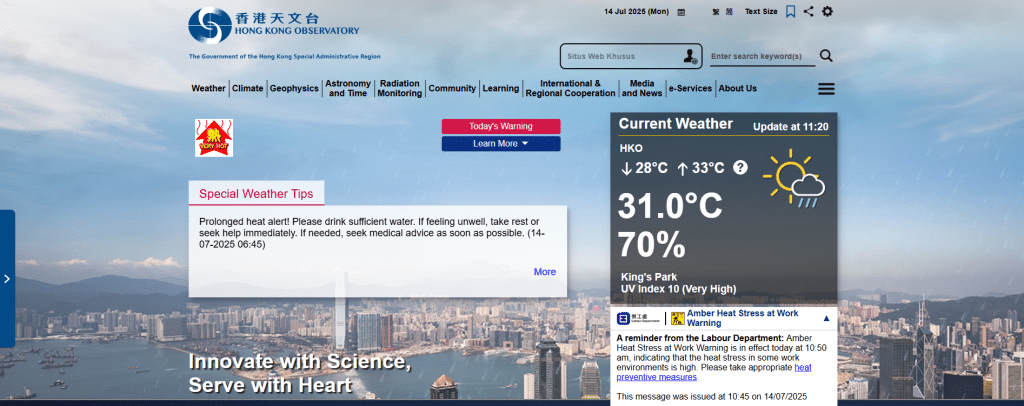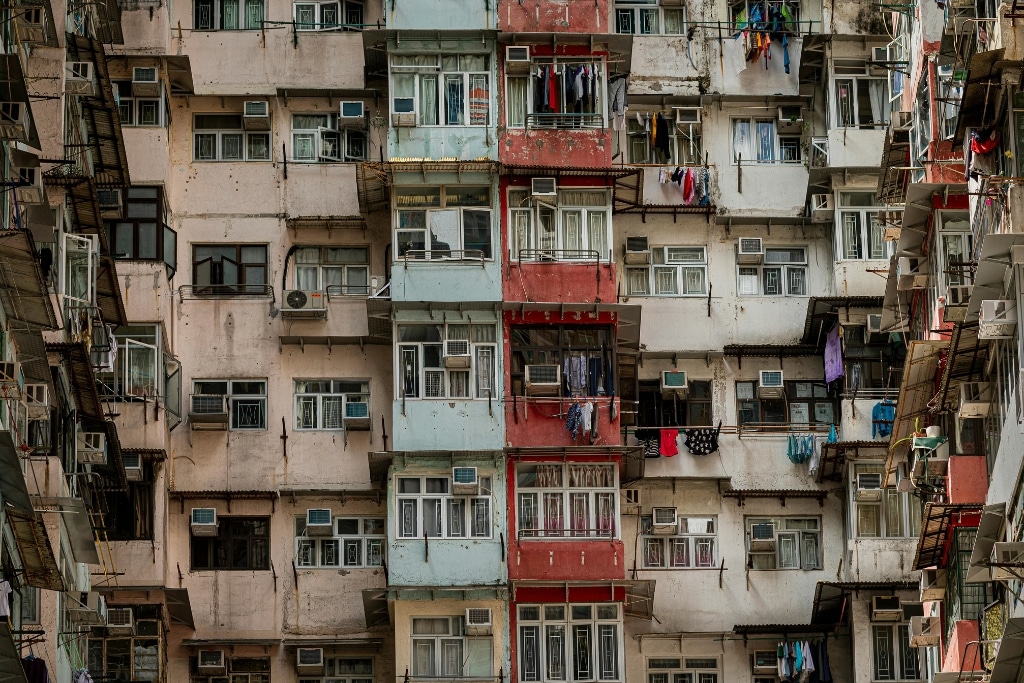As extreme heat intensifies, Hong Kong’s most vulnerable populations find themselves on the frontlines of a growing climate crisis, highlighting a stark divide between those who can escape the heat and those who cannot.
—
Ling Chan, a street cleaner in her 70s, is one of Hong Kong’s thousands of outdoor workers enduring the sweltering summer heat with minimal protection.
She recalled suffering from heatstroke last year – the city’s hottest on record: “Suddenly I felt dizzy. I immediately had to sit down on a bench. I had never sat down before while working, that was the first time,” she told Earth.Org in Cantonese.
Hong Kong broke 35 temperature records in 2024, including the warmest April and first half-year on record.
With temperatures rising in the city, in line with the global trend, the government in 2023 implemented a three-tier Heat Stress at Work Warning system ranging from amber to red and black, advising employers to provide rest breaks to prevent heatstroke among outdoor workers.
Under a red or black alert, bar benders and porters are advised to stop work completely, while other outdoor workers should be granted more rest time.

Despite the new system, many workers like Chan often experience heat-related symptoms while working, including tiredness, thirst, headaches, dizziness, rises in body temperature and nausea.
The street cleaner told Earth.Org that she rarely takes breaks, fearing she will be reported for “looking unprofessional” – a sentiment echoed by other outdoor workers across the city interviewed by Earth.Org.

Seeking shade in a back alley with a portable fan near a garbage collection point in Tsuen Wan, a cleaner surnamed Yu said workers often do not have anywhere to hide from the heat.
“The weather is too hot to bear. Even taking a breath is difficult, let alone working. The exhaust in the back alley is terrible – there’s air conditioner exhaust and the oily fumes from the cha chaan tengs [Hong Kong-style cafes],” he told Earth.Org in Cantonese.
On July 8, Hong Kong recorded its hottest Xiaoshu since 1884, with temperatures reaching 34.3C. Xiaoshu, the 11th solar term in the traditional Chinese calendar, marks the start of summer’s hottest period. But heat has been persisting for longer, with the city’s Observatory issuing the earliest “Very Hot Weather” Warning on record on April 15.

A food delivery worker surnamed Ng reported experiencing heat rash and skin peeling from sun exposure. “When you go out at noon, it’s easy to get sunburned because your body isn’t used to it,” he said in Cantonese.
Ng added that riders must provide their own protective equipment as companies like Foodpanda and Keeta offer little support for heat protection.
Last year, the Association for the Rights of Industrial Accident Victims, a non-profit, said that nearly 40% of 470 workers it interviewed between late June to mid-August reported that their employers had not provided them with any measures to help prevent heat stress.
A postal worker who asked to remain anonymous revealed that despite working nine hours a day in extreme heat, he receives only 20 minutes for breaks.
“In order to meet our daily targets, we have no other way,” he said in Cantonese, adding that he delivers an average of 16 kilograms of mail daily.
Indoor Furnaces
While outdoor workers struggle under the sun, residents of subdivided flats face equally dangerous conditions indoors.
Hong Kong recorded a maximum temperature of 36.5C in the first week of July, but temperatures inside subdivided flats could be even higher, according to a study by the Society for Community Organisation (SoCO), a local non-governmental human rights advocacy group.
From May to July, the organization surveyed 334 people living in inadequate housing and measured daily temperatures in 11 units. They found that temperatures in these cramped living spaces soared to highs of 40C.

For an elderly subdivided flat tenant surnamed Fong in Kwai Chung, the reality is inescapable: “It’s like living in a steamer. Last summer there were a lot of bed bugs. We couldn’t live in peace,” he told Earth.Org in Cantonese in a phone call.
When the heat becomes unbearable, Fong takes frequent showers and visits shopping malls to cool down, he said.
SoCO also noted that some rooftop slums and cage homes remain boiling hot even with air conditioners running because they are directly exposed to sunlight.
“Many [subdivided unit tenants] experience indoor temperatures that are hotter than outdoors,” SoCO’s Deputy Director Sze Lai-shan told Earth.Org in a phone call. “For the rooftop units, since they’re directly on the top floor and the materials sometimes don’t resist heat well, they are almost always the hottest.”
The economic burden compounds the physical discomfort, with Fong reporting that his electricity bill triples or quadruples during summer months due to air conditioning use.
In response to the sentiment expressed by the subdivided unit residents it surveyed, SoCO urged the government to establish a permanent scheme of subsidies for energy bills, such as monthly allowances, in the long term.
The Way Forward
Noting a gap between official policies and meaningful protection, environmentalists are stepping up to address these climate inequities.
Founded in 2021, the Community Climate Resilience Concern Group has been working to create accessible cooling spaces throughout Hong Kong.
“There are temporary heat shelters in Hong Kong, but only 19 across all 18 districts. Not all of these shelters are open during daytime, and their locations may not be accessible to the most vulnerable groups,” said Blaire Ho, a member of the youth-led organisation.

In 2022, the group launched a project partnering with cafes and bookshops to provide free cooling spaces for vulnerable populations. These rest stations now span eight districts with more than 10 partner locations.
“We’re trying to change the agenda of using public space to see if they can offer the space freely while it can serve the uses of climate adaptation as well,” Ho told Earth.Org in a phone call. The team has also been collecting heat relief items, such as fans and hats, to distribute to those in need.

Beyond creating physical spaces, the group emphasized the need for education and awareness. “We really hope to raise public awareness because in our education, no one has ever taught us that everyone experiences climate change differently,” said member Osbert Leung.
Looking ahead, the group called on policymakers to design public spaces that better account for the unequal impact of climate change.
Featured image: Kelly Yu/Earth.Org.
💡How to stay safe in extreme heat
- 💧Stay hydrated: Drink around two liters of water per day, or about eight glasses. In heat conditions, experts recommend drinking throughout the day and urinating around six to seven times a day, or every two to three hours.
- 🍉Eat nutritious food: Stick to hydrating, fresh food such as watermelon, peaches, berries, grapes, and oranges, vegetables that can be juiced, as well as liquid meals such as soups. Avoid spicy foods, known to make the body sweat. Avoid cooking at home, and opt for the microwave instead of the oven if you have to.
- 💦Exercise responsibly: If you exercise outdoors, take breaks in the shade or indoors to allow your body to cool down faster. Wear sensible attire, such as lightweight, loose-fitting clothing made of breathable fabrics, such as cotton, linen, bamboo, polyester, nylon and microfiber. Hydrate well before a workout and drinking throughout every 15-20 minutes, especially when the physical activity lasts longer than an hour.
- 🌡️Follow local weather services: Check local meteorological services or news channels regularly, as they provide real-time updates and alerts about heat advisories and warnings. Local governments and emergency management agencies often post timely updates on social media platforms as well so keep them monitored.
- 📱Use weather apps: Download reputable weather apps that provide notifications about extreme heat conditions. Many of these apps allow users to set alerts for specific weather events in their area.
- ❗Sign up for emergency alerts: Many cities have rolled out local emergency notification systems or community alert programs that citizens can easily enroll in. These services often send text or email alerts directly to residents during extreme weather events, including heatwaves.
For more tips, check out our article on this topic. To learn more about the risks of extreme heat and how the world is adapting, you can read our 3-part series on extreme heat.
This story is funded by readers like you
Our non-profit newsroom provides climate coverage free of charge and advertising. Your one-off or monthly donations play a crucial role in supporting our operations, expanding our reach, and maintaining our editorial independence.
About EO | Mission Statement | Impact & Reach | Write for us









